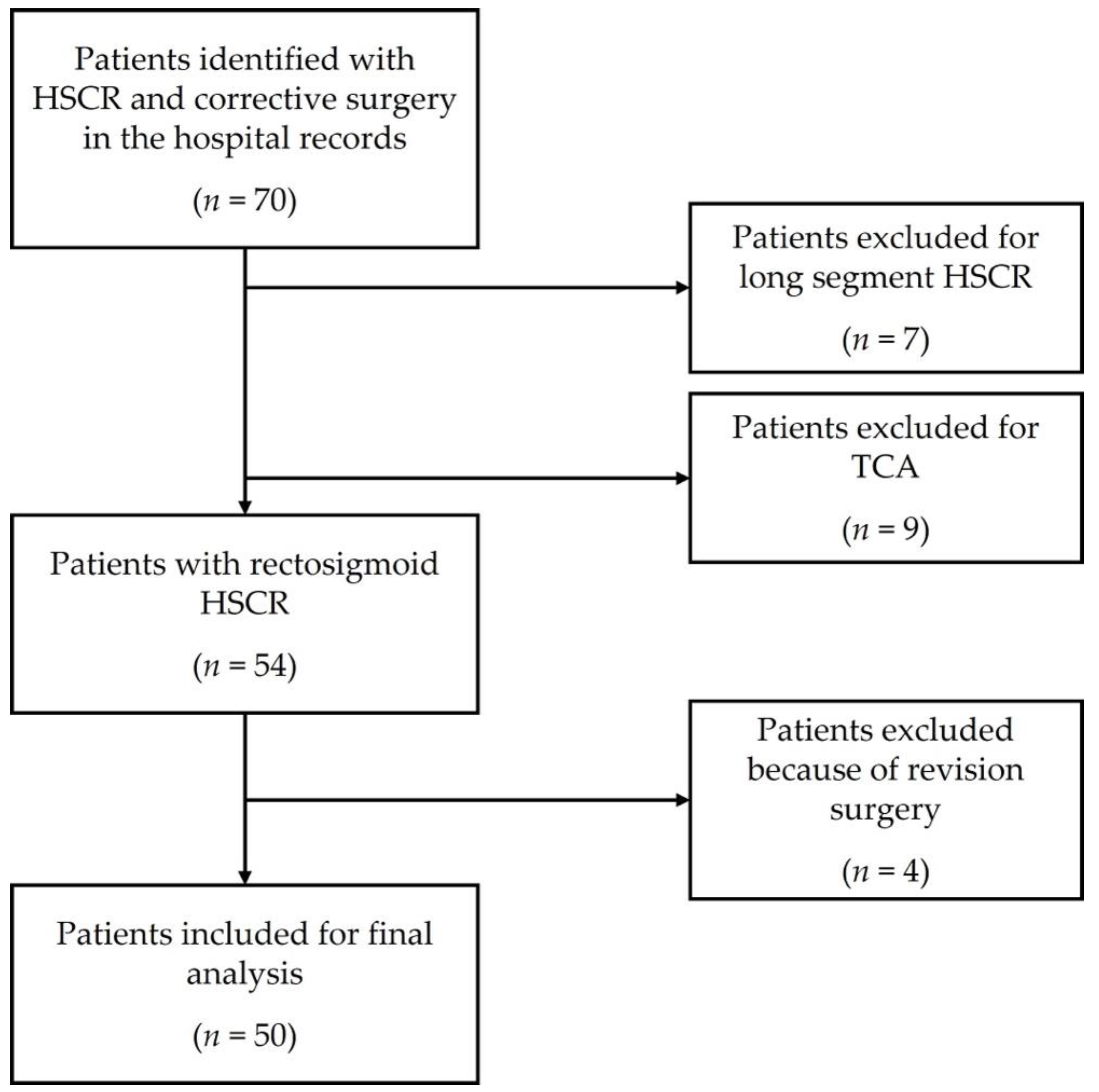The Length of the Transition Zone in Patients with Rectosigmoid Hirschsprung Disease
Abstract
:1. Introduction
2. Materials and Methods
3. Results
4. Discussion
5. Limitation
6. Conclusions
Author Contributions
Funding
Institutional Review Board Statement
Informed Consent Statement
Conflicts of Interest
References
- Moore, S.W.; Zaahl, M.G. Intronic RET Gene Variants in Down Syndrome-Associated Hirschsprung Disease in an African Population. J. Pediatr. Surg. 2012, 47, 299–302. [Google Scholar] [CrossRef] [PubMed]
- Coyle, D.; O’Donnell, A.M.; Tomuschat, C.; Gillick, J.; Puri, P. The Extent of the Transition Zone in Hirschsprung Disease. J. Pediatr. Surg. 2019, 54, 2318–2324. [Google Scholar] [CrossRef] [PubMed]
- Thakkar, H.S.; Blackburn, S.; Curry, J.; de Coppi, P.; Giuliani, S.; Sebire, N.; Cross, K. Variability of the Transition Zone Length in Hirschsprung Disease. J. Pediatr. Surg. 2020, 55, 63–66. [Google Scholar] [CrossRef] [PubMed] [Green Version]
- White, F.V.; Langer, J.C. Circumferential Distribution of Ganglion Cells in the Transition Zone of Children with Hirschsprung Disease. Pediatr. Dev. Pathol. 2000, 3, 216–222. [Google Scholar] [CrossRef] [PubMed]
- Kyrklund, K.; Sloots, C.E.J.; de Blaauw, I.; Bjørnland, K.; Rolle, U.; Cavalieri, D.; Francalanci, P.; Fusaro, F.; Lemli, A.; Schwarzer, N.; et al. ERNICA Guidelines for the Management of Rectosigmoid Hirschsprung’s Disease. Orphanet J. Rare Dis. 2020, 15, 164. [Google Scholar] [CrossRef] [PubMed]
- Georgeson, K.E. Laparoscopic-Assisted Pull-through for Hirschsprung’s Disease. Semin. Pediatr. Surg. 2002, 11, 205–210. [Google Scholar] [CrossRef] [PubMed]
- Bawazir, O.A. Laparoscopic-Assisted Transanal Pull-Through in Hirschsprung Disease: Does Laparoscopic Dissection Minimize Anal Overstretching? J. Laparoendosc. Adv. Surg. Tech. 2020, 30, 338–343. [Google Scholar] [CrossRef] [PubMed]
- Ghosh, D.N.; Liu, Y.; Cass, D.T.; Soundappan, S.S.V. Transition Zone Pull-through in Hirschsprung’s Disease: A Tertiary Hospital Experience. ANZ J. Surg. 2017, 87, 780–783. [Google Scholar] [CrossRef] [PubMed]
- Kapur, R.P. Histology of the Transition Zone in Hirschsprung Disease. Am. J. Surg. Pathol. 2016, 40, 1637–1646. [Google Scholar] [CrossRef] [PubMed]
- Kapur, R.P.; Kennedy, A.J. Histopathologic Delineation of the Transition Zone in Short-Segment Hirschsprung Disease. Pediatr. Dev. Pathol. 2013, 16, 252–266. [Google Scholar] [CrossRef] [PubMed]
- Kapur, R.P.; Kennedy, A.J. Transitional Zone Pull through: Surgical Pathology Considerations. Semin. Pediatr. Surg. 2012, 21, 291–301. [Google Scholar] [CrossRef] [PubMed]
- Bradnock, T.J.; Knight, M.; Kenny, S.; Nair, M.; Walker, G.M. The Use of Stomas in the Early Management of Hirschsprung Disease: Findings of a National, Prospective Cohort Study. J. Pediatr. Surg. 2017, 52, 1451–1457. [Google Scholar] [CrossRef] [PubMed]
- Stensrud, K.J.; Emblem, R.; Bjørnland, K. Late Diagnosis of Hirschsprung Disease--Patient Characteristics and Results. J. Pediatr. Surg. 2012, 47, 1874–1879. [Google Scholar] [CrossRef] [PubMed]
- Hagens, J.; Reinshagen, K.; Tomuschat, C. Prevalence of Hirschsprung-Associated Enterocolitis in Patients with Hirschsprung Disease. Pediatr. Surg. Int. 2021, 38, 3–24. [Google Scholar] [CrossRef] [PubMed]
- Frykman, P.K.; Short, S.S. Hirschsprung-Associated Enterocolitis: Prevention and Therapy. Semin. Pediatr. Surg. 2012, 21, 328–335. [Google Scholar] [CrossRef] [PubMed] [Green Version]





| Characteristic | n (%) | ||
|---|---|---|---|
| Sex | |||
| Male | 35 (70%) | ||
| Female | 15 (30%) | ||
| Age at Diagnosis in Months | |||
| <1 | 19 (38%) | ||
| 1–6 | 16 (32%) | ||
| 6–12 | 5 (10%) | ||
| >12 | 10 (20%) | ||
| Mean Age at Diagnosis | Mean Age at Pull-Through | ||
| <1 | 0.4 | 4.0 | |
| 1–6 | 2.4 | 4.3 | |
| 6–12 | 9.0 | 11.4 | |
| >12 | 41.2 | 45.6 | |
| Mean Length of TZ in cm | Mean Length of AZ in cm | ||
| <1 | 3.1 | 11.0 | |
| 1–6 | 2.2 | 6.5 | |
| 6–12 | 1.3 | 9.5 | |
| >12 | 3.0 | 8.3 | |
| Pull-Through Procedure | |||
| Primary | 31 (62%) | ||
| Two-Stage (Stoma) | 19 (38%) | ||
| Mean Age Distribution for Two-Stage (Stoma) in months | |||
| <1 | 4/19 (21%) | ||
| 1–6 | 4/16 (25%) | ||
| 6–12 | 3/5 (60%) | ||
| >12 | 8/10 (80%) | ||
| Nonsyndromic | 41 | ||
| Syndromic | 9 | ||
| Trisomy 21 | 5 | ||
| Others | 4 | ||
| Familial | 2 | ||
Publisher’s Note: MDPI stays neutral with regard to jurisdictional claims in published maps and institutional affiliations. |
© 2022 by the authors. Licensee MDPI, Basel, Switzerland. This article is an open access article distributed under the terms and conditions of the Creative Commons Attribution (CC BY) license (https://creativecommons.org/licenses/by/4.0/).
Share and Cite
Tomuschat, C.; Mietzsch, S.; Dwertmann-Rico, S.; Clauditz, T.; Schaefer, H.; Reinshagen, K. The Length of the Transition Zone in Patients with Rectosigmoid Hirschsprung Disease. Children 2022, 9, 152. https://doi.org/10.3390/children9020152
Tomuschat C, Mietzsch S, Dwertmann-Rico S, Clauditz T, Schaefer H, Reinshagen K. The Length of the Transition Zone in Patients with Rectosigmoid Hirschsprung Disease. Children. 2022; 9(2):152. https://doi.org/10.3390/children9020152
Chicago/Turabian StyleTomuschat, Christian, Stefan Mietzsch, Sebastian Dwertmann-Rico, Till Clauditz, Hansjoerg Schaefer, and Konrad Reinshagen. 2022. "The Length of the Transition Zone in Patients with Rectosigmoid Hirschsprung Disease" Children 9, no. 2: 152. https://doi.org/10.3390/children9020152
APA StyleTomuschat, C., Mietzsch, S., Dwertmann-Rico, S., Clauditz, T., Schaefer, H., & Reinshagen, K. (2022). The Length of the Transition Zone in Patients with Rectosigmoid Hirschsprung Disease. Children, 9(2), 152. https://doi.org/10.3390/children9020152






